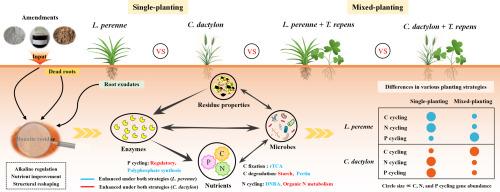不同种植策略下改良铝土矿残渣养分循环微生物调控的宏基因组研究:对土壤形成的影响
IF 5
2区 农林科学
Q1 SOIL SCIENCE
引用次数: 0
摘要
铝土矿渣的可持续修复依赖于植物有效养分的持续供应,而功能性微生物群落在养分循环中起着关键作用。然而,微生物功能基因在改性铝土矿渣中调控植物生长早期营养循环的机制尚不清楚。本研究通过温室盆栽试验,利用宏基因组测序技术,研究了不同种植策略下黑麦草(Lolium perenne)、长尾草(Cynodon dactylon)和三叶草(Trifolium repens)的碳(C)、氮(N)和磷(P)循环相关微生物功能基因的变化。结果表明,种植显著降低了土壤碱度(pH值降低1.58 ~ 1.67个单位),提高了土壤养分有效性,其中速效氮和速效磷分别提高了12.47 ~ 18.00倍和4.07 ~ 8.56倍,酶活性从过氧化氢酶到脲酶提高了4.18 ~ 179倍。主要的C循环途径是还原三羧酸(rTCA)循环(28.1 - 29.2%)和二羧酸-4-羟基丁酸(DC4HB)循环(29.1 - 30.4%)。氮循环主要通过有机氮代谢介导(47.6 - 49.0%),而磷循环主要由易位相关过程驱动(35.0 - 36.9%)。种植多年生黑麦草促进了碳的固存,而种植短齿草促进了氮、磷的循环。值得注意的是,与三叶草混种会削弱与碳、氮、磷循环相关的某些代谢途径。共现网络分析表明,大多数营养循环基因呈正相关,glpx-SEBP、gltB和phoU是关键调控基因。偏最小二乘路径模型(PLS-PM)表明,种植通过改善秸秆理化性质直接提高酶活性,并通过改变细菌群落组成间接调节C、N、P循环基因。变形菌门和放线菌门始终占C、N和P循环基因群的主导地位。这些发现为微生物调控土壤养分循环提供了机制上的见解,并为铝土矿渣可持续修复的种植策略提供了依据。本文章由计算机程序翻译,如有差异,请以英文原文为准。

Metagenomic insight into microbial regulation of nutrient cycling in amended bauxite residue under various planting strategies: Implications for soil formation
Sustainable rehabilitation of bauxite residue relies on a consistent supply of plant-available nutrients, with functional microbial communities playing a pivotal role in nutrient cycling. However, the mechanisms by which microbial functional genes regulate nutrient cycling during early plant growth in amended bauxite residue remain poorly understood. In this study, we conducted a greenhouse pot experiment to examine shifts in microbial functional genes related to carbon (C), nitrogen (N), and phosphorus (P) cycling under various planting strategies, including single and mixed plantings of Lolium perenne, Cynodon dactylon, and Trifolium repens, using metagenomic sequencing. Results showed that planting significantly reduced alkalinity (pH decreased by 1.58–1.67 units) and enhanced nutrient availability, with available N and P increasing by 12.47–18.00-fold and 4.07–8.56-fold, respectively, while enzyme activities increased 4.18–179-fold, from catalase to urease. Dominant C cycling pathways were the reductive tricarboxylic acid (rTCA) cycle (28.1–29.2 %) and the dicarboxylate-4-hydroxybutyrate (DC4HB) cycle (29.1–30.4 %). N cycling was primarily mediated through organic nitrogen metabolism (47.6–49.0 %), whereas P cycling was driven by translocation-related processes (35.0–36.9 %). Planting with Lolium perenne enhanced C sequestration, whereas Cynodon dactylon promoted N and P cycling. Notably, mixed planting with Trifolium repens weakened certain metabolic pathways related to C, N, and P cycling. Co-occurrence network analysis indicated that most nutrient cycling genes were positively correlated, with glpx-SEBP, gltB, and phoU identified as key regulatory genes. Partial least squares path modeling (PLS-PM) revealed that planting directly enhanced enzyme activity by improving residue physicochemical properties and indirectly regulated C, N, and P cycling genes through shifts in bacterial community composition. Proteobacteria and Actinobacteria consistently dominated C, N, and P cycling gene groups. These findings provide mechanistic insights into microbial regulation of nutrient cycling and inform planting strategies for sustainable bauxite residue rehabilitation.
求助全文
通过发布文献求助,成功后即可免费获取论文全文。
去求助
来源期刊

Applied Soil Ecology
农林科学-土壤科学
CiteScore
9.70
自引率
4.20%
发文量
363
审稿时长
5.3 months
期刊介绍:
Applied Soil Ecology addresses the role of soil organisms and their interactions in relation to: sustainability and productivity, nutrient cycling and other soil processes, the maintenance of soil functions, the impact of human activities on soil ecosystems and bio(techno)logical control of soil-inhabiting pests, diseases and weeds.
 求助内容:
求助内容: 应助结果提醒方式:
应助结果提醒方式:


